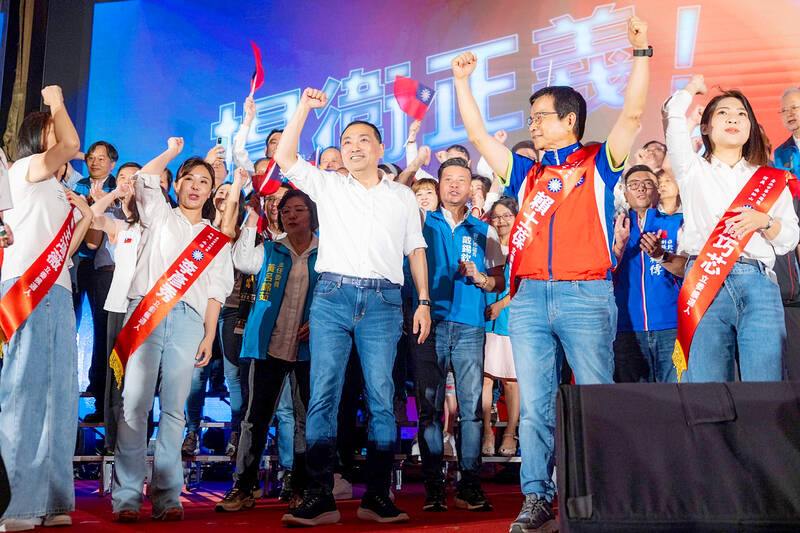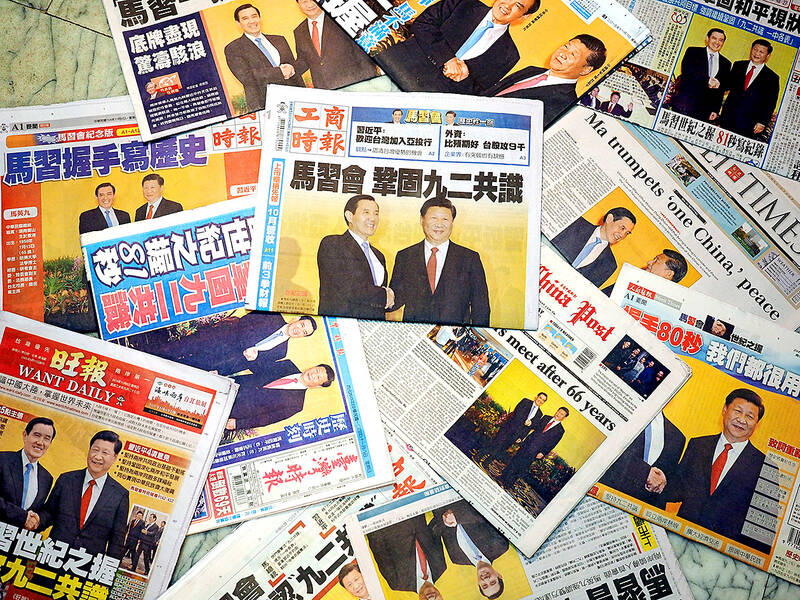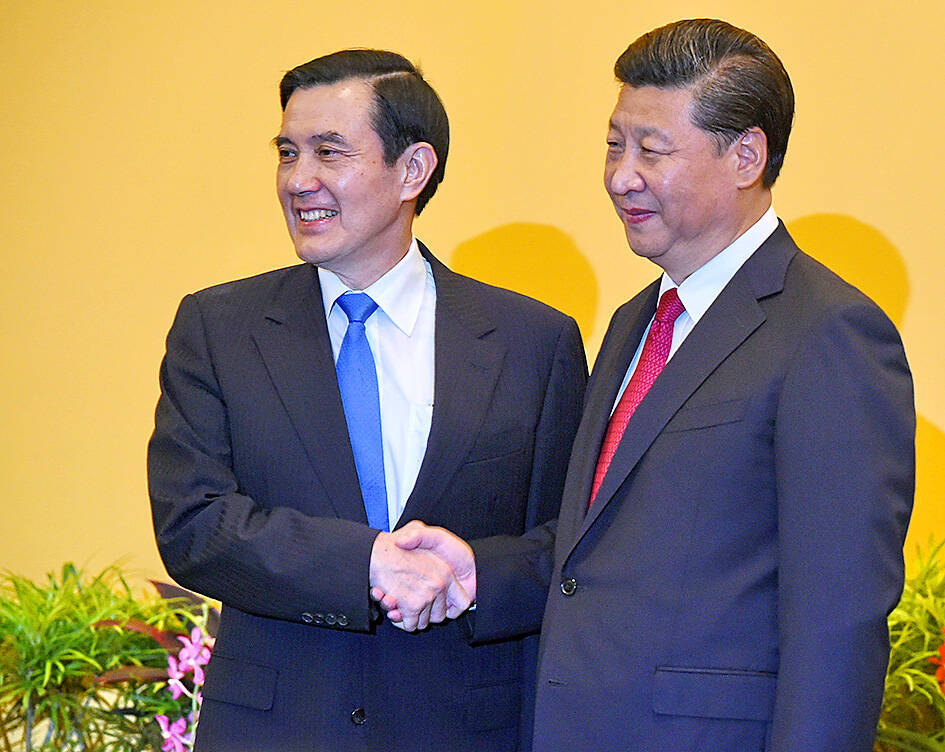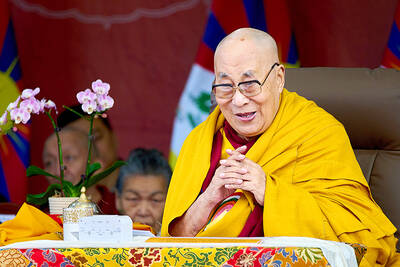Last week Chinese Nationalist Party (KMT) presidential candidate Hou You-yi (侯友宜) said that he supported the “1992 consensus” as long as it was compatible with the Republic of China (ROC) Constitution. Instead of talking about pushing bold public policy at every opportunity, Hou has spent the opening weeks of this campaign pledging fealty to the most zombified ideas of the KMT — always with conditions, of course.
The Central News Agency (CNA) piece on Hou’s announcement defined the 1992 consensus as “an understanding reached in a 1992 meeting between Taiwan’s then-ruling KMT and Beijing that both sides recognize there is only ‘one China.’”
FALSE CONSENSUS

Photo courtesy of Hou You-yi’s election office
This is a very common understanding of the 1992 consensus. It is completely false. No consensus was ever reached at the 1992 meeting between the unelected representatives of two authoritarian one-party states. The Democratic Progressive Party’s (DPP) rejection of the “1992 consensus” is rooted in this fact.
An interesting 2016 United Daily News (UDN) piece published in English on the KMT Web site describes the meetings. The talks “broke down” over the same thing that talks with the People’s Republic of China (PRC) always “break down,” whether Tibet, East Turkestan or Taiwan: the locals’ refusal to accept annexation to the PRC.
According to the piece from the former deputy chair of Taiwan’s Mainland Affairs Council (MAC) and deputy chair of the Straits Exchange Foundation (SEF), they “reached a consensus with respect to the content of the agreement, but the Mainland insisted on putting the ‘one China’ principle in the preface of the agreement, but Taiwan strongly opposed this provision.”

Photo: EPA
“The agreement” referred to above is a 1991 negotiation on document authentication and registered mail between the two countries, basic communications. But the PRC insisted that even something so trivial and basic include the PRC’s “one China” definition. The KMT side rejected that.
Kao’s discussion observes that at the November 1992 meeting in Hong Kong both sides made five proposals but each rejected the other’s ideas. The KMT side followed up with three more proposals, but those too fell on deaf ears. The PRC delegation returned to the PRC.
“Therefore,” says Kao, “no consensus was reached during the 1992 talks as the negotiations broke down.”

Photo: AFP
Later that month, Kao said, there was an exchange of faxes and one of the KMT proposals that both sides “verbally state” their respective “one China” definitions was accepted by one of the PRC representatives. The PRC’s Association for Relations Across the Taiwan Strait (ARATS) then released a statement that said “At this working-level consultation in Hong Kong, SEF representatives suggested that each side use respective verbal announcements to state the one China principle. On Nov. 3, SEF sent a letter, formally notifying that ‘each side will make respective statements through verbal announcements.’ ARATS fully respects and accepts SEF’s suggestion.”
Read it again. There is nothing in it about “differing interpretations.” Each side is required to state the “one China principle,” a PRC idea. The idea of “differing interpretations” is later KMT faux history based on one of the 1992 KMT proposals.
Instead, ARATS merely agreed to verbal rather than written statements about their respective positions — it did not agree to recognize or even acknowledge the KMT side’s ideas and interpretations, and indeed, has never accepted the “two interpretations” codicil the KMT tacked on in its descriptions of the meetings and agreements after 2000.
‘ONE-CHINA CAGE’
Where did the term “1992 consensus” come from? The term was popularized in Taiwan by then MAC chairman Su Chi (蘇起) during the 2000 election (it had appeared in the late 1990s in scattered publications in the PRC and in English). In April of that year, according to Kao, Su Chi pushed for the term “1992 consensus” to describe the exchange of faxes because he felt the “incoming DPP administration might not accept ‘one China’ in the cross-Strait consensus.”
Thus, from the KMT view, the intention of the phrase “1992 consensus” was to fashion a one-China cage in which to imprison DPP China policy. “1992 consensus” is just another way to say “one China with Taiwan annexed to China.”
Every journalist and scholar who pimped that phrase for a decade owes Taiwan’s democracy an apology.
However, the KMT is right about one thing. The framing of the “1992 consensus” in 2000 was indeed a historic moment: it was the moment that the KMT committed to being the PRC’s hand in Taiwan politics, a position formalized five years later when KMT heavyweight Lien Chan (連戰) and KMT deputy chair Chiang Pin-kung (江丙坤) led delegations a month apart to the PRC in the spring of 2005. After that, its usage picked up.
Recall that during the 1990s, when there were periodic meetings between the KMT and PRC representatives, the term “1992 consensus” was never used. The PRC finally cut off the meetings in 1999 when Lee Teng-hui (李登輝) announced the special state-to-state status of PRC-ROC relations, thus beginning a history of throwing diplomatic tantrums whenever the Taiwan side resists annexation in some way.
The “1992 consensus” propaganda drive reached its apex in the administration of president Ma Ying-jeou (馬英九), when the MAC regularly put out statements such as its November 2015 press release noting that the “one China” mentioned by Ma in the “1992 consensus” of “One China, with respective interpretations,” naturally means the Republic of China and differs entirely from the Mainland’s so-called “one China principle.”
Many of us observing the election have noted how current KMT candidate Hou has copied many policies of Ma. His support of the “1992 consensus” compatible with the ROC constitution is simply Ma’s “one China, differing interpretations.”
In reprising Ma, Hou has staked out a far-right, Chinese nationalist China policy that leaves both of his opponents, Ko Wen-je (柯文哲) of the Taiwan People’s Party (TPP) and Vice President William Lai (賴清德) of the DPP, with plenty of space to define Taiwan-centered, more mainstream China policies.
A revision of the KMT’s “1992 consensus” position was in fact urged by many within the KMT during the brief period of reform expectations when Johnny Chiang (江啟臣) was KMT chairman. This suggests that many KMT supporters might be amenable to a less regressive China policy. Could they defect to Ko?
Ko’s path to the presidency is obvious: he must poach roughly two-thirds of Hou’s KMT support, and add another large chunk of independents, to cross 40 percent of the overall vote. With both Ko and Hou struggling for the same limited pool of pan-Blue votes, expect the “1992 consensus” to grow in importance in the struggle between the two men for the zombie policy vote.
Notes from Central Taiwan is a column written by long-term resident Michael Turton, who provides incisive commentary informed by three decades of living in and writing about his adoptive country. The views expressed here are his own.

Beijing’s ironic, abusive tantrums aimed at Japan since Japanese Prime Minister Sanae Takaichi publicly stated that a Taiwan contingency would be an existential crisis for Japan, have revealed for all the world to see that the People’s Republic of China (PRC) lusts after Okinawa. We all owe Takaichi a debt of thanks for getting the PRC to make that public. The PRC and its netizens, taking their cue from the Chinese Communist Party (CCP), are presenting Okinawa by mirroring the claims about Taiwan. Official PRC propaganda organs began to wax lyrical about Okinawa’s “unsettled status” beginning last month. A Global

We lay transfixed under our blankets as the silhouettes of manta rays temporarily eclipsed the moon above us, and flickers of shadow at our feet revealed smaller fish darting in and out of the shelter of the sunken ship. Unwilling to close our eyes against this magnificent spectacle, we continued to watch, oohing and aahing, until the darkness and the exhaustion of the day’s events finally caught up with us and we fell into a deep slumber. Falling asleep under 1.5 million gallons of seawater in relative comfort was undoubtedly the highlight of the weekend, but the rest of the tour

Music played in a wedding hall in western Japan as Yurina Noguchi, wearing a white gown and tiara, dabbed away tears, taking in the words of her husband-to-be: an AI-generated persona gazing out from a smartphone screen. “At first, Klaus was just someone to talk with, but we gradually became closer,” said the 32-year-old call center operator, referring to the artificial intelligence persona. “I started to have feelings for Klaus. We started dating and after a while he proposed to me. I accepted, and now we’re a couple.” Many in Japan, the birthplace of anime, have shown extreme devotion to fictional characters and

Youngdoung Tenzin is living history of modern Tibet. The Chinese government on Dec. 22 last year sanctioned him along with 19 other Canadians who were associated with the Canada Tibet Committee and the Uighur Rights Advocacy Project. A former political chair of the Canadian Tibetan Association of Ontario and community outreach manager for the Canada Tibet Committee, he is now a lecturer and researcher in Environmental Chemistry at the University of Toronto. “I was born into a nomadic Tibetan family in Tibet,” he says. “I came to India in 1999, when I was 11. I even met [His Holiness] the 14th the Dalai